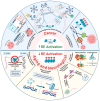Evolution of Repetitive Elements, Their Roles in Homeostasis and Human Disease, and Potential Therapeutic Applications
- PMID: 39456183
- PMCID: PMC11506328
- DOI: 10.3390/biom14101250
Evolution of Repetitive Elements, Their Roles in Homeostasis and Human Disease, and Potential Therapeutic Applications
Abstract
Repeating sequences of DNA, or repetitive elements (REs), are common features across both prokaryotic and eukaryotic genomes. Unlike many of their protein-coding counterparts, the functions of REs in host cells remained largely unknown and have often been overlooked. While there is still more to learn about their functions, REs are now recognized to play significant roles in both beneficial and pathological processes in their hosts at the cellular and organismal levels. Therefore, in this review, we discuss the various types of REs and review what is known about their evolution. In addition, we aim to classify general mechanisms by which REs promote processes that are variously beneficial and harmful to host cells/organisms. Finally, we address the emerging role of REs in cancer, aging, and neurological disorders and provide insights into how RE modulation could provide new therapeutic benefits for these specific conditions.
Keywords: co-option; epigenetic alteration; genomic instability; novel antigens; repetitive elements; transposable elements; viral mimicry.
Conflict of interest statement
The authors declare no conflicts of interest.
Figures



Similar articles
-
Erratum: Eyestalk Ablation to Increase Ovarian Maturation in Mud Crabs.J Vis Exp. 2023 May 26;(195). doi: 10.3791/6561. J Vis Exp. 2023. PMID: 37235796
-
Using Experience Sampling Methodology to Capture Disclosure Opportunities for Autistic Adults.Autism Adulthood. 2023 Dec 1;5(4):389-400. doi: 10.1089/aut.2022.0090. Epub 2023 Dec 12. Autism Adulthood. 2023. PMID: 38116059 Free PMC article.
-
Depressing time: Waiting, melancholia, and the psychoanalytic practice of care.In: Kirtsoglou E, Simpson B, editors. The Time of Anthropology: Studies of Contemporary Chronopolitics. Abingdon: Routledge; 2020. Chapter 5. In: Kirtsoglou E, Simpson B, editors. The Time of Anthropology: Studies of Contemporary Chronopolitics. Abingdon: Routledge; 2020. Chapter 5. PMID: 36137063 Free Books & Documents. Review.
-
Ethics of Procuring and Using Organs or Tissue from Infants and Newborns for Transplantation, Research, or Commercial Purposes: Protocol for a Bioethics Scoping Review.Wellcome Open Res. 2024 Dec 5;9:717. doi: 10.12688/wellcomeopenres.23235.1. eCollection 2024. Wellcome Open Res. 2024. PMID: 39839977 Free PMC article.
-
Child, family and professional views on valued communication outcomes for non-verbal children with neurodisability: A qualitative meta-synthesis.Int J Lang Commun Disord. 2024 Nov-Dec;59(6):2946-2984. doi: 10.1111/1460-6984.13121. Epub 2024 Oct 17. Int J Lang Commun Disord. 2024. PMID: 39417318 Review.
References
Publication types
MeSH terms
Grants and funding
LinkOut - more resources
Full Text Sources

